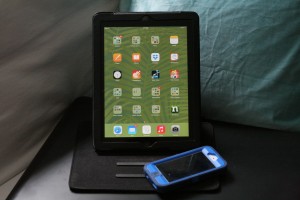
Technology. The rate at which the human race can access information is getting faster everyday, thanks to many human’s brains that are wired to think up very unique and complicated processes to make so many things accessible to us. On a “smart device” just by using a finger, or even voice recognition systems, the world is revealed. Society is making great strides towards making many things that were once hard to find, more readily available to general public.
This is great news for many parents, because their busy lives may be made slightly simpler, and when they are shopping at the store their child may be allowed to browse “PBS Kids” learning apps on their iPad mini instead of pulling cereal off the shelf or learning shapes and colors in the backseat instead of crying loudly on the way to pick up their sibling from soccer practice.
Technology is helping many of us in countless ways. New inventions like improved voice command have made it possible for children and adults with special needs to learn and access needed information that otherwise would be difficult for them to attain. Many people have contact with the outside world which they did not have before due to their difficulty getting out often in their wheelchair, just because of a Skype application. But technology can also at some point be a hindrance to us, especially to children who are growing and developing. A smart device can be easy to put in front of them to take the place of a human teacher…and I can venture to say that we are all aware that it is human touch and the combination of physical/cognitive/emotional input and challenge that helps us truly grow.
These smart devices are now being used in music therapy sessions all over the country, in innovative and exciting ways to enhance learning and take our sessions to a whole new level. Here are just a few of hundreds of examples how a smart device can positively influence a session for multiple populations:
- Record music on the spot for loved ones
- Assist therapist and student learn new songs instantly
- Read music at a hospital bedside without all the fuss of papers and notebooks
- Access supportive, fun children’s music games where they can learn about instruments and see different types from all over the world
- Rhythm and sound processing applications to enhance speech/vocal/rhythmic interventions
- Academic/cognitive processing applications
These smart devices can be used to enhance thought processing, attention span, joint attention with screen and manipulated object, academic concepts, fine motor skills, instrument conception, and the list goes on. I have recently begun using iPad in sessions as a back up tool to enhance learning and a reward towards the ends of a successful session for a client. I truly believe that technology can help clients of all ages.
Technology, however, if used poorly can become a replacement for other needed human interaction and human experience. I have seen instances where there is a void between a parent and child in many areas because the child is minute by minute using a smart device as a constant replacement for communication or learning. Devices are used (often unknowingly) as a replacement for a parent-child bond, or human interaction in general. We need to be very careful about this. Many of us know that there are extremes to everything, and I am stating an extreme. But this “extreme” is becoming more prevalent in our society than we realize. We often (even well functioning socially adjusted adults) use our cell phones daily as an excuse not to make eye contact or speech with others in the office building, on the sidewalk, or in a cafe. While this is often just an excuse of simple convenience and privacy, it shows us how easy it would be for an eight year old autistic child to use his smart communication device as a shelter and friend rather than just a tool to help him learn to communicate more on his own.
Let us not forget that although technology has helped us cross so many barriers, it can also become a barrier to us and to our children in their growth and development in regards to humanity. Technology is not at all a fit replacement for learning, human interaction, therapeutic stimulation. Music therapy and other therapies should never be replaced by an object alone. And neither should any schooling for that matter. Even online school degrees must be accompanied by “hands-on” learning for a specific period of time.
Remember that dynamic, irreplaceable growth only occurs in an appropriate, sustainable environment where a child has successful and meaningful interaction with other human beings on a regular basis. This interaction can most definitely be enhanced by technology, but the challenge is – to never let a screen take your place.
Sign your child up for successful, meaningful, and fun music therapy sessions today!
Submitted by Joy Hinson, MT-BC